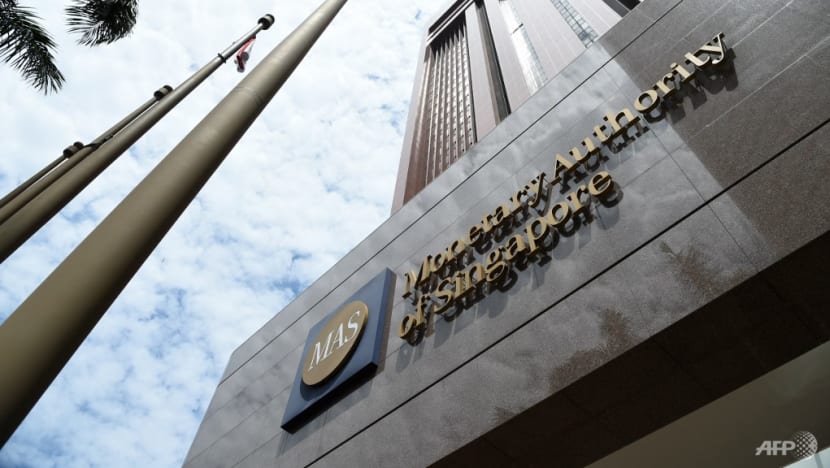MAS move to tighten monetary policy off-cycle not surprising, further action in Oct a possibility: Analysts
One analyst said he had expected a move by Singapore's central bank but not this early.

The Monetary Authority of Singapore building. (File photo: AFP)
SINGAPORE: Experts say that the Monetary Authority of Singapore’s (MAS) off-cycle move on Thursday (Jul 14) to tighten monetary policy was not an entirely surprising one and further action is still a possibility.
This follows the announcement by MAS that it would be taking a "further calibrated step" to do so amid rising inflation. This step involves re-centering the mid-point of the Singdollar nominal effective exchange rate (S$NEER) policy band up to its prevailing level.
It is the fourth time since October last year that MAS has tightened its monetary policy. The adjustment falls outside of MAS' normal cycle of twice-yearly monetary policy reviews, typically in April and October.
MAS added that core inflation is expected to rise above 4 per cent in the near term. It is projected to be between 3 per cent and 4 per cent this year, up from the earlier forecast of 2.5 per cent to 3.5 per cent.
CIMB Private Banking economist Song Seng Wun noted that he had expected a move by the MAS but not this early.
“Over the recent weeks there suddenly has been speculation that the MAS may do another out-of-meeting move, but this came a bit earlier than we have expected," he told CNA, adding that he thought the central bank might have waited until after the release of June's consumer price index data.
Data last month showed that headline consumer price index, or overall inflation, rose to 5.6 per cent year-on-year in May.
“We were not all that surprised to see another off-cycle tightening by the MAS as short-end rates have clearly signalled an intention to keep the currency on the stronger side. But we had expected the adjustment to happen after an inflation data release,” said ING economist Nicholas Mapa in a report.
Ms Selena Ling, who is chief economist and head of treasury research and strategy at OCBC Bank, said that this latest off-cycle move signifies some “policy resolve” to tamp down imported inflation.
She added that the move was “not completely unexpected” as the S$NEER was “elevated near the top end of its parity band".
Mr Yu Liuqing, who is country analyst for Asia at the Economic Intelligence Unit, said that it was "quite unusual" for MAS to make two out of-cycle moves, the first being in January this year.
It also shows the "commitment" from MAS to tame inflationary pressure, added Mr Yu, who noted that the timing of the move was a surprise to him.
Unlike most central banks that manage monetary policy through the interest rate, MAS uses the exchange rate as its main policy tool.
This refers to the S$NEER – the exchange rate of the Singapore dollar managed against a trade-weighted basket of currencies from Singapore’s major trading partners.
MAS allows the S$NEER to float within an unspecified band. Should it go out of this band, it steps in by buying or selling Singapore dollars.
It also changes the slope, width and mid-point of the band based on assessed risks to the country’s growth and inflation,
Compared to tweaks in the slope, an adjustment in the mid-point either upwards or downwards is likely to yield a quicker and bigger impact on the currency, economists have said.
What the move means is a possible strengthening of the Singapore dollar, in order to reduce the impact of rising prices.
“For Singaporeans, this move will help contain imported inflation but not completely offset the growing inflationary pressures,” said Ms Ling.
“All we can do is contain as much as possible as much of the price increase as possible, with a slightly stronger exchange rate,” added Mr Song.
FURTHER TIGHTENING IN OCTOBER A POSSIBILITY
The last time MAS announced it would be tightening its monetary policy was in April when it released its half-yearly policy statement. Then, the central bank also said it would re-centre the mid-point of its exchange rate policy band at the prevailing level of the S$NEER.
It also said it would “increase slightly” the rate of appreciation of the band to “exert a continuing dampening effect on inflation”.
Between now and October, Mr Song said that there would likely be no off-cycle adjustments to further tighten monetary policy. However, he added that there could be further tightening in October.
Concurring with this was Mr Mapa of ING, who wrote: "With forecasts pointing to even higher inflation prints down the road, we consider it likely that we will see further action by the MAS at the October meeting."
"The hurdle for further off-cycle moves from here is very high," said OCBC's Ms Ling. "However, the external and domestic growth-inflation situation remains very dynamic, so I wouldn’t say another tightening is totally off the table at this juncture."

















